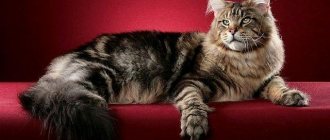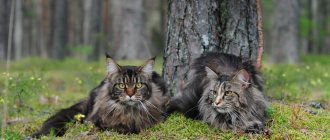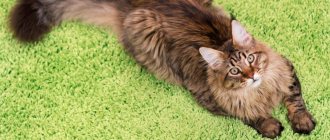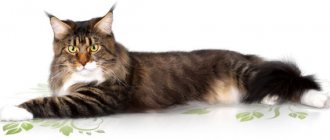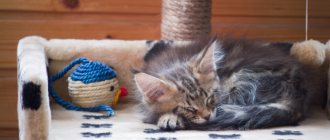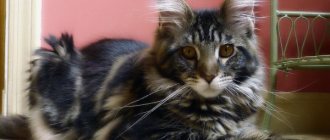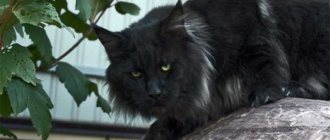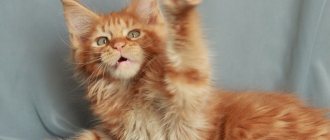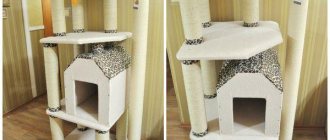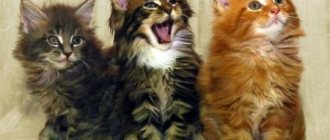Maine Coon cats are gaining popularity. There are many people who want to have such a cat. And demand determines supply, which is expressed both in an increase in the number of the breed and in an increase in the cost of kittens. Few people in the current situation can afford such expenses. Therefore, there is a demand for mixed breeds of this breed. Mixed breeds are not mongrels; they carry the genotype from Maine Coons. It’s worse when they try to sell ordinary cats to buyers under the guise of mestizos—this is obvious deception and fraud. The difference between a purebred and an ordinary cat is very noticeable.
Head shape
Experts say that one of the main distinguishing features of a real Maine Coon is the geometrically correct shape of the lower part of the muzzle. Due to its characteristic symmetry, it is a square. A powerful chin gives the muzzle a brutal and somewhat menacing appearance. Maine Coons are given additional severity by the serious look of their slanted eyes.
This is interesting: Photo of a red Maine Coon
About the origin
Most Maine-Coon mixes are born as a result of random matings. For example, when, having taken his pet with him to the dacha, the owner did not think that his fluffy beauty would probably attract the neighbor’s outbred cat as a bride. However, sometimes interbreed matings are also the result of the activities of unfortunate breeders who decided to see what would happen if they mated a Maine Coon cat, for example, with a British cat.
Interbreeding is a lottery in which it is impossible to predict how genes will fall.
Kittens born from such a mating will most likely turn out to be different from Maine Coons. In addition, there is a high risk that they will be predisposed to many diseases.
Body type
Maine Coons are distinguished by their impressive size and weight. The documented body length record is 120 cm. The weight of adult individuals ranges from 8 to 12 kg. The dimensions of kittens from birth are 1.5–2 times greater than those of half-breeds. The weight of Maine Coons is 150–200 g, while ordinary babies weigh no more than 100 g.
If an adult cat weighs less than 7 kg, it is most likely a mixed breed.
Pedigree kittens are also characterized by skeletal development. By 3–4 months, the body and limbs are stretched. Kittens become like “bicycles” and “laces”. They gain weight much later. But even a newborn Maine Coon baby stands out with its massive, wide paws.
Participation in exhibitions, documents
This American cat breed was formed many years ago. The task of breeders is to preserve and improve the gene pool. The participation of a simple cat in breeding negates their efforts.
Due to such factors, owners of hybrids cannot exhibit their pets in the breed ring. However, exhibitions where animals of unknown origin are judged are open to them. There they can show the pet and get a description if the cat is healthy, has a beautiful exterior, and an easy-going character. When the kittens grow up, it will become clear how large they will grow and what their show potential will be.
Useful to read: Features of carriers for Maine Coons
They are allowed into the ring upon reaching 10 months of age. The rules are the same as at regular exhibitions. Separate rings, strict judging. A mongrel pet is prepared with full responsibility: grooming, purchasing accessories. This is a great chance to show your favorite cats to specialists and get a lot of positive emotions from communicating with like-minded people.
Outbred cats are not registered anywhere. They cannot have a pedigree, only a veterinary passport with notes on vaccinations and treatment against worms, which the owner obtains at his own request. Subsequent mating with a coon will still result in his phenotype, and not a true Maine cat.
Varieties
Throughout the existence of Maine Coons, attempts were made from time to time to cross them with other cats in order to create a new breed. For example, in order for the Siamese color to appear in the breed, they tried to cross them with Siamese cats. But all the hybrid kittens and their descendants did not inherit the desired qualities and were not like their parents, and therefore there was no need to talk about breeding a new breed. What other Maine Coon crosses exist and how do they differ from purebred animals?
Crossed with a Siberian cat
The main advantage of a cross with a Siberian cat is the thick, long and fluffy fur that is common to representatives of both breeds, so such kittens will certainly be fluffy. They can also be larger in size than regular cats. A mixed breed with a Siberian cat will never reach the size of a Maine Coon and the characteristic tufts on his ears will also not appear. In addition, such cats will have a different head shape and a more massive build.
As a rule, mixed breeds with Siberian cats are quite affectionate, although less intelligent.
British mix
This British cross will have traits such as a calm disposition, quick wit, distrust of strangers and neatness. She will be smaller than the Maine Coon, she will have a fairly large and wider muzzle. If this is a kitten from a mating with a British Longhair, then it will grow up to be semi-longhaired. These mestizos are friendly and get along well with children, in addition, they are quite smart and quick-witted , although they are inferior in this regard to purebred cats.
Half-breed with a Norwegian cat
Such a mixed breed will probably be quite large and fluffy, with thick and dense water-repellent fur. He will probably even have small tufts on his ears, typical of Norwegians. The character of such a kitten is a little similar to the character of the Maine Coon: the mestizo will have a well-developed hunting instinct, and he will also be quite affectionate and affectionate towards people.
It should be remembered that even such a kitten may be completely different from either of its parents: it all depends on how the genes are distributed.
A cross between a normal cat
The most unpredictable combination, since an ordinary domestic cat can be the result of a mixture of many breeds. Here there is no need to talk about the similarity of mestizos with Maine Coons both in terms of appearance and character. With a high degree of probability, a mixture of genes from other breeds will turn out to be more dominant and will not allow even one or two of the characteristic breed characteristics of the original breed to appear. Perhaps such mestizos will grow a little larger than ordinary cats. They are also likely to have fairly thick, but somewhat short, fur.
Unique and unpredictable mestizos
Metis is the result of crossing cats of different breeds. Or outbreds. In general, any cats without a pedigree are called mestizos. They inherit the best qualities of their parents: endurance, intelligence, health. Among the mestizos, no two cats are alike. Each of them has a unique appearance. What purebred representatives of cat breeds cannot boast of.
Metis are the most common cat breed on earth.
Mestizos are very diverse. It is possible to predict the temperament and appearance of a cat only if it was born in a nursery or at home and the parents are known. The kitten inherits behavioral patterns from its father and mother. The character of mestizos depends on their upbringing and habitat. Life experience is what shapes the personality of a half-breed. If a mixed breed of an elite breed is raised and nurtured as an aristocrat, he will exhibit traits inherent in the breed. And when a cat has to fight for his life, all manifestations of character will be aimed at survival.
The history of cohabitation between humans and cats goes back more than 10 thousand years. In ancient times, cats were not distinguished into separate breeds. Depending on the region of residence, climate, and nutrition, they had different appearance and character traits. Later, with the development of navigation, it became possible to mate cats from different regions. Then the first mestizos appeared.
Felinologists were divided into two camps. Some breeders do not recognize mestizos as full-fledged cats and mercilessly cull them. Others, on the contrary, consider mixed cats smarter, more educated, more resilient than purebred cats and endowed with properties unattainable for aristocrats.
Mixed breeds do not meet breed standards, so they are not sold. Or they charge a symbolic price. A gifted kitten is believed to bring good luck.
Description of the animal
Purebred animals are divided into European and American. Which, in turn, are divided into the Shaw, Brid and Pet classes, distinguished by their large size, rich coat and tassels on the ears. When breeding, Norwegian forest seals are often found, mutations in the form of polydactyly - more than 16 fingers and Dutch rex - coons with curly hair. Maine Coon mixed breeds, like any other breed, are a mixture of the blood of parents of different origins. This can be a purebred and yard cat, or any other purebred with a representative of the animal in question. Such a pet may look different, depending on which genes were passed on from its ancestors.
Types and how to recognize?
In most cases, mestizos are born from random mating; they are not specially bred.
The cat breed in question is distinguished by its large size, large ears with tufts, semi-long hair, a wide chest, strong bones and a long tail. The Maine Coon hybrid has generally accepted types, such as:
- si-kun - a mixture with Siamese;
- Renegade is a cross between a Bengal cat.
A mixed breed cat is undesirable for experienced breeders, most often resulting from accidental mating of animals. The most unpredictable results are obtained from Sphynx cats or yard cats. A half-breed will look different depending on what breed was present in the cross. More details are presented in the table:
| Cats with which Maine Coons were crossed | What do they look like? |
| Kitten from a Persian | Large red kittens with fluffy and soft fur |
| Half-breeds with a Bengal mix | When trying to crossbreed with a Maine Coon, they do not have similarities with both breeds in frequent cases |
| British Scottish Straight mix | The result looks like an ordinary large-sized yard short-haired kitten, not similar to either a British cat or a Maine Coon |
| Hybrid from Scottish Fold | Gives an unpredictable result, in rare cases similar to a fold-eared cat |
| A cross between a Maine Coon and a Siberian cat | Red and tabby cat of outbred appearance |
| Bred with an ordinary cat | A cross between a Maine Coon and a regular cat also looks like yard animals |
| Sphinx mix | Unpredictable result, most often having sphinx ears and fluffy fur |
Maine Coon mixed breed: types
The cross between a Maine Coon and a regular cat has quite a rich history. A large number of experiments were carried out on crossing with the Siamese cat. It was planned that the result would be a large animal with long hair and a characteristic color. Unfortunately, these experiments failed because the results were not consistent.
Maine Coon and Bengal cat mixes look like barn cats
For your information! Maine Coons were crossed with representatives of a variety of breeds, including Persian, “British”, and Siberian.
Mixed Maine Coon and regular cat
Mixture between a Maine Coon and a non-pedigreed cat does not happen very often. At least the breeders don’t cross them on purpose. Such a crossbreed can appear as a result of accidental mating.
The resulting offspring with a high degree of probability will not be able to boast of distinctive thoroughbred features. In addition, if the non-pedigreed parent has short hair, the kittens born will most likely also have short hair.
Maine Coon and British mix
This is a losing proposition and will not bring breeders any new purebred species. The bottom line is that a half-breed Maine Coon, crossed even with a purebred “British”, looks like an ordinary yard cat, maybe a little fluffier and larger.
Note! In fact, the kitten is not similar to any of the specified breeds. Given the length of the coat of the “British”, the crossbreed is most often born with short hair.
Mixed Siberian cat and Maine Coon
The Siberian cat itself is quite large, with a thick fluffy coat. In terms of crossing with a Maine Coon, she can become one of the more or less suitable options.
Externally, kittens look like fluffy, red, striped. However, even in this case, the cat most closely resembles a yard cat.
Maine Coon and Scottish Fold mix
A mixture with Scottish Fold gives the most unpredictable results. In rare cases, offspring appear that have characteristics of the fold-eared breed.
Mixed Maine Coon and Bengal cat
In most cases, the offspring do not have similar characteristics to any of the above breeds. Such crossing, like most, is a failure and does not bring permanent results.
Wool
Maine Coons have fluffy, thick, but at the same time soft hair. The pants, chest and belly have especially long pile. The undercoat is also silky and delicate. A characteristic detail is long tufts of fur between the toes.
According to the rules, the pedigree of a real Maine Coon is confirmed by a pedigree of at least 4 generations. Conscientious breeders give up kittens at the age of 3 months. If the seller offers younger pets, you should seriously think about purebred.
Mestizos are often not inferior in beauty to purebred individuals, although they are smaller. But if the goal is to acquire a Maine Coon, it is worth taking into account the listed signs and evaluating the kittens according to their presence. If you have any doubts about your own competence, it is better to consult a professional breeder.
(17 votes, average: 3.4 out of 5)
Differences between mestizos and purebred kittens
It is impossible to determine the breed by color, since the coat colors of “Americans” are the same as those of ordinary cats.
If you cross a long-haired Maine Coon with a short-haired cat, the cross will have short hair. And if both parents have long fur, then the cubs will have the same coat. A mestizo may exhibit polydactyly (six-fingered feet), a mutation characteristic of the American breed.
The character of mestizos is impossible to predict. Ordinary cats are more aggressive and independent, while the behavior of the Maine Coon is affectionate and friendly. There is a high probability that the kittens will acquire the character of the outbred parent.
Body dimensions are also unpredictable. But most often large half-breeds are born. As adults, they are slightly smaller than the Maine Coon parent. It is noteworthy that in one litter there can be mixed breeds of different sizes.
You can tell whether a baby is mixed or purebred when he reaches 3 months of age. Signs of mestizo:
- Absence of tufts on the ears, characteristic of a purebred Maine Coon.
- Less strong and heavy paws.
- Less long and strong tail.
- The shape of the muzzle is typical for natural cats, without cheekbones, elongation and the characteristic box chin.
How to tell the difference?
The older the kitten, the easier it is to understand whether it is purebred or not.
By about three months, purebred Maine Coon babies acquire tufts on their ears, which are one of the most characteristic features of the breed.
Mixed-breed or outbred kittens usually do not have ear tufts.
In addition, a purebred Maine Coon has wide and strong paws at a very early age with tufts of hair between the toes, and a long and powerful tail.
The head and muzzle of a purebred baby is elongated and wide-cheeked; later it will acquire the so-called “box” shape characteristic of a representative of this breed. And in general, such a kitten looks much larger than its peers. Already at one and a half months he is the same size as a six-month-old young cat of another breed.
The only reliable confirmation of the Maine Coon breed is documents on the origin of the kitten.
Below is a selection of photos of purebred representatives of this breed.
Characteristic signs
The brightest representatives of this breed have a very specific appearance, which differs from the appearance of yard and mongrel cats.
The main signs that distinguish a Maine Coon from an ordinary cat:
- Americans are famous for their large, triangular ears that point upward, rather than forward, as with ordinary cats. There is also a small tassel at the tip - the main distinguishing feature of the breed.
- Elongated head shape with large and high cheekbones. When viewed from the front, the head appears square-shaped.
- Purebred representatives of the breed have fox eyes, almond-shaped. They are characterized by slanting, and not roundness, like other cats.
- The animal boasts dense and voluminous fur of medium length. As for color, there are two genetic colors: red, black, all other colors are considered shades.
- The breed is distinguished by its strong and wiry build. As well as a heavy skeleton and a wide chest. Another feature of the pet is its very long tail, it is almost twice as long as the others.
One way to distinguish a Maine Coon cat is to find out its age. Kittens are large in size; a five-week-old pet has the same weight as an ordinary outbred cat that is six months old.
Is it worth buying a half-breed kitten?
How to name a Maine Coon boy or girl
Most owners prefer mestizos not because of their external features, but because the price is lower than for a purebred cat. It is also believed that if the baby has purebred parents, then genes will appear in the kitten. However, in most cases this opinion is erroneous.
Half-breed is an unpredictable pet
It should be understood that a half-breed is not the same thing as a purebred cat. No one can ever guarantee what a kitten will look like when it grows up and what its character will be like. The reason is precisely that purebred Maine Coons are freedom-loving, and even the British gene cannot correct this.
The correct approach to breeding is also important. Irresponsibility can result in a mixed-breed kitten becoming aggressive, sickly, or mentally unstable.
Advantages and disadvantages of a crossbreed
The positive aspect of such half-breeds is their low cost. Most mestizos are friendly and sociable, but there are exceptions. Another advantage is flexibility and affection for a person.
Also, the Maine Coon gene has a positive effect on the intelligence of a cat. Such animals understand and remember commands well and quickly get accustomed to the tray.
As for the disadvantages of mestizo, first of all it is the loss of a thoroughbred pedigree. In this case, there can be no talk of any exhibitions. In addition, if a male and a female of a smaller breed are crossed, there is a risk of death of the mother due to the birth of a large fetus.
Important! If a person nevertheless decides to get a crossbreed, it is worth contacting an experienced breeder to rule out problems with the health and psychological state of the animal.
Mestizos scam
Those wishing to own a Maine Coon should beware of unscrupulous owners. They can easily sell a furry baby under the guise of a purebred and keep silent about its true parents.
Mitten paws
How to buy a purebred coon
First of all, if you need a purebred cat, you should ask for a pedigree. This is not just a piece of paper, but a document that the cat really belongs to the declared breed and is not a crossbreed.
Where is the best place to buy kittens so as not to buy a mixed breed?
Real purebred kittens are purchased from official nurseries or from trusted breeders.
Important! You should not be fooled by the offer to take an unplanned kitten for a lower price. Pedigree cats are bred strictly and in accordance with the established mating plan.
A purebred kitten cannot be cheap
As you can understand, a half-breed kitten is not uncommon, and in itself is not something bad. If the breeder does not intend to show the animal at exhibitions, he may well purchase a pet at a very reasonable price.
Possible offspring
No significant changes are expected in terms of coat color. Most domestic cats without admixture from other breeds have the colors acceptable in Maine Coon Cats. But genetics suggests unexpected results. Mutations, such as polydactyly, which is common in coons, are likely to affect part of the litter. Coat color and pattern are inherited according to established laws.
Useful to read: How much do Maine Coons cost?
Science knows interesting facts about eye color. Usually it does not depend on the color of the coat, but blue pigment accompanies color-point colors (Siamese cats), and less often white. In practice, if you cross a green-eyed coon with a blue-eyed female, the offspring will most likely take after the father for this trait. This happens because green is dominant to blue. When white kittens are born, the situation may change.
All Maine Coon cats have medium-length fur. If you cross a representative with a smooth cat, the litter will be short-haired. The birth of kittens with long hair is possible if there are two long-haired parents.
Character and behavior are unpredictable in this combination. Street cats are more aggressive by nature, this is dictated by the laws of survival in difficult conditions. Pedigree cats are softer, because purposeful work has been carried out for decades to consolidate behavior that is comfortable for humans.
Weight and body structure are also difficult to calculate, but most half-breeds are distinguished by their impressive dimensions, although they are inferior to their purebred parents. Kittens are born with different characteristics, some are smaller, some are larger.
Metis requires the same careful attention as a purebred animal. A balanced diet, walks, and the love of the owner are mandatory criteria for the happiness of any pet.
Types of colors and their descriptions
Based on the basic colors of Maine Coons, breeders have developed many new colors of the breed. The most valuable of them are single-color variations and covers with a clearly defined pattern or spots.
Tabby
Tabby is a color with stripes. There are additional features:
- The presence of stripes of medium thickness on the muzzle, which outline the eyes and appear in the letter “M” on the cat’s forehead.
- Each hair itself is striped. Light and dark alternate with each other along the entire length. This phenomenon is called "agouti".
The Maine Coon tabby color exists in several subspecies:
- classic;
- brindle;
- ticked;
- spotted
Regardless of the type of tabby pattern, it can be anything that the breed allows. But agouti ranges from light blue to bright red.
Solid
Solid is a monochromatic color. It appeared due to the suppression by breeders of the gene that is responsible for the appearance of the pattern on the coat of a cat of this breed. Respectable Maine Coons do not have obvious stripes or tan marks. But this does not mean that the cat is not a carrier of a recessive gene. Therefore, monochromatic parents may well have tabby-colored kittens.
Solid color comes in the following options:
- black;
- blue;
- red;
- white;
- cream.
A Maine Coon with a black solid color is quite a rare occurrence. Black solid kittens may have subtle stripes, but as they grow, they are completely hidden behind the monochrome.
Solid Blue Maine Coons have no visible stripes and have a beautiful gray coat. Blue Maine Coons often have piercing green eyes.
The red Maine Coon is also somewhat of a rarity. Red shades are typical for most cats, but it is quite difficult to hide the presence of stripes with such pigmentation. Therefore, finding a monochrome ginger cat is quite difficult. Solid light and cream Maine Coons are even rarer.
Tortoiseshell
Tortoiseshell color means that the cat's coat has one predominant color, which is decorated with spots of a contrasting shade. They are located throughout the body in a chaotic manner.
Tortoiseshell colors come in:
- Sitseva. On the fur, markings in the form of patches of basic colors prevail, sometimes white ones are also found, then the color is called “tortoiseshell with white”.
- Pictured. The spots contain a pattern in the form of stripes or stains.
- Scaly. Red and black markings alternate like scales.
- Solid. The spots of basic shades are large in area and stand out with clear boundaries.
Smoky (silver) color
All smoky Maine Coons are united by the obligatory presence of a black or blue “collar”, the tips of the hair of which are painted white.
Depending on the color intensity, the following subspecies of smoky colored cats are distinguished:
- chinchilla (only the tips of the hairs are colored);
- shaded smoke (hairs are colored exactly a quarter);
- black smoke or blue smoke (white color is only at the base of the hair);
- true smoke (hairs are exactly half colored);
- silver (the hair is white at the base and silver at the tip);
- cream (kittens of this breed are born with brilliant white fur, but become cream as they grow older).
Color with white spots
Maine Coon with white spots is another result of the efforts of breeders. This color appeared because many people thought the coloring was spectacular, and the previously missing white markings were considered a defect in the breed.
The main thing for a color with white spots is the clarity of the boundaries. Color variations do not depend on the intensity of the color, but on the number and method of distribution of specks:
- “gloves” (only the bottom of the paws is white);
- van (white color predominates, but the head and tail remain colored);
- “medallion” (white mark on the chest);
- “buttons” (one or more randomly located spots);
- bicolor (white markings are combined with another color in a 1:1 ratio);
- harlequin (a white cat with several large colored markings);
- “tuxedo” (“gloves” and “medallion” are combined with a dark color on the back).
External features of cats
When crossing representatives of different breeds, there is a risk that the offspring will not inherit any desired characteristics. There is a general description of the external parameters of mestizos.
A mixed breed of Maine Coon and Siberian cat resembles a purebred cat in appearance. The colors and shape of the skull are similar. There are almost no external signs of Siberian admixture. At the same time, such mixtures do not grow to large sizes. In addition, such individuals do not have tufts on their ears.
Mixed Maine Coon and Siberian cat
Mixing a Maine Coon with a barn cat leads to the appearance of kittens that resemble a purebred animal in color and strong bones. At the same time, they are distinguished by a less flexible character. In addition, not all the positive qualities of a purebred animal will be passed on to the offspring. In rare cases, kittens have tassels. Such mestizos reach large sizes.
Maine Coon and barn cat mix
Crossing Persians and Maine Coons produces large kittens. They have fluffy fur, often red in color. Externally, the offspring resembles a Persian.
Persian and Maine Coon mix
When representatives of the breed are mixed with a Scottish Fold cat, offspring will appear that are similar in appearance to the mother. Crossing with a Sphynx results in kittens with a fluffy body and erect large ears. If a Briton is involved in the crossing, the offspring will not resemble the purebred parents. The kitten will have medium length fur and a large head.
Crossing with a Norwegian cat allows you to get large kittens covered with thick hair that is water-repellent. Often, such mestizos begin to have tufts on their ears at 3 months.
Mixed Norwegian cat and Maine Coon
Choosing a mixed-breed cat
Every cat is unique. But experts believe that by external signs - the shape of the skull, body structure, color and length of fur - it is possible to predict the character traits of a pet from a very young age. And even a predisposition to disease. Mixed breeds of elite cats inherit from their parents the appearance and behavior pattern characteristic of a particular breed. When choosing a mestizo, you should pay attention to the main phenotypes. Try to determine from them what character the cat will have and its future health problems.
"Marquise" phenotype
Short, black fur with white spots. The body constitution of cats is dense, while that of cats is thin. This phenotype is characteristic of short-haired European breeds. These pets have a stable, predictable character. They demonstrate their desires quite clearly. They try to manage the house and achieve their goal with affection or perseverance. They have good health. With poor nutrition, urolithiasis can develop.
Phenotype "Siberian cat"
The color is gray-striped. The coat is long with a thick undercoat. The body is loose or dense. The head is large, round, with a protruding muzzle. Confident, independent character. These animals are “on their own.” They skillfully put the owners in the desired place and show who is boss in the house. They accept affection solely of their own free will. They don't like it when they are bothered with attention. May experience digestive problems. Suffer from obesity, diabetes, urolithiasis,
Angora cat phenotype
Long or semi-long light coat. Dry, tender body. Elegant, light head. Having an independent disposition, they show miracles of devotion and trust in the owner. Sensing the weakness of the owner, they can show “savagery” and aggressiveness, defending themselves and protecting the territory. They need daily human contact. The owner is expected to be predictable and stable. Health is good. Problems with respiratory function and infections are possible.
"British" phenotype
The coat is dense and short. The head is round, large, with erect ears. The body structure is rough and dense. Tabby and blue-gray color. The tail is thick, with transverse stripes. Independent character. Showing displeasure, they can be stubborn and aggressive. These cats are not easy to handle. Touching is allowed, guided solely by one’s own mood. They often become “masters of masters.” Like all cats with a rough constitution, they have a tendency to chronic kidney diseases and obesity. And also, endocrine system disorders and chronic pancreatitis.
Phenotype "Persian cat"
The coat is long, silky, without coarse guard hairs. The head is round, the nose is flattened. The body constitution is rough or loose. They have an independent character and position themselves as a decoration for the home. They can be capricious and demanding. Persians and mestizos are often cut like a lion. Since long hair needs to be combed, and Persians do not like this procedure. Predisposed to diseases of the genitourinary system and upper respiratory tract.
Phenotype "oriental cat"
A cat with short, delicate fur. Thin, dense skeleton with developed muscles. The body is elongated. Quite heavy with an elegant appearance. Light, graceful head. Large or medium movable ears. The color is varied: spotted, solid, striped, color-point, tabby and others. Due to their focus on the owner and the need for constant communication, they are called “cat-dogs”. Orientals have irrepressible energy. Need active games. If energy is not used, obesity may begin. They strive to restore order in the house. Health is quite good. They may have digestive problems and infections.
Phenotype "Thai cat"
Semi-long or short coat of characteristic colors: blue point, seal point, lilac tabby point, lilac point. The head is round. Eye color is blue. Strong, graceful cats with a dense, but not coarse constitution. The character is even, non-conflicting. The behavior model is close to that of a dog. They need constant contact with the owner. They are acutely aware of his mood swings. Empathizing with the problems of the owners, they can get sick. They are very persistent in achieving their goals. They achieve their goals not through arrogance and aggression, but through persistence and affection. Health is quite good, but they are susceptible to urolithiasis and slow infections.
Taking into account the external signs of the pet, it is possible to predict the future character and behavioral model. Take measures for proper education and prevent possible diseases.
Advantages and disadvantages
The main advantage of half-breeds is their moderate cost. And mestizos are also very flexible and friendly. Despite their origin, such pets will be devoted and loyal friends. Another positive quality is the loving and sociable nature of cats.
They can be compared to small children, because they love affection and attention very much, they gladly reciprocate their feelings to their owner.
Developed intelligence allows you to carry out various commands, and easy receptivity to information will help you quickly accustom the kitten to the litter box. Mestizos have strong immunity, they get sick less. In terms of appearance, they are in no way inferior to purebred cats. Their unusual color and fluffy tail can charm anyone. To avoid surprises, before purchasing such a pet, you should carefully study information about its parents.
Disadvantages include the lack of pedigree and the inability to participate in exhibitions.
It is undesirable for mestizos to reproduce, as there is a huge risk of the cat dying during childbirth due to the large size of the kittens.
Reviews from owners of mixed-breed cats
People pay a lot of money for purebreds in order to brag about it to their relatives or friends. Or people buy expensive animals with the prospect of making money on it, for the purpose of further breeding and resale. As for intelligence and ingenuity, it’s possible! After all, breeders develop cat breeds not only based on the external qualities of the breed, but also on the internal ones: mental stability, aggressiveness, ability to train, etc. It is difficult to judge, because in one litter of even the most thoroughbred there can be different specimens with different psychos. qualities. The same can be said about mestizos. My opinion is that all cats are almost equally smart and smart. Everything will depend on the conditions of their detention and, of course, the actions of the owner (training).
binom[9.1K]
Features and risks of breeding
You should not hope that a mixed-breed kitten will look like a real Maine Coon. Indeed, during interbreeding, the characteristic traits inherent in representatives of a given breed appear extremely rarely, even individually, and never all at once. Even if the resulting kittens are a little larger than babies from a cat of another breed and a little fluffier, they will still be very different from purebred animals.
The amazing character of Maine Coons, which so distinguishes them from ordinary cats, is also, as a rule, not passed on to mixed-breed kittens. In addition, the more breeds are mixed, the greater the risk of genetic diseases or congenital pathologies.
Mating a Maine Coon cat with a representative of another breed is also fraught with the fact that due to the very large size of the kittens, the cat may simply not give birth and die.
Finally, there is a risk that mixed-breed kittens, which have disappointed their new owners because they are different from purebred animals, may end up on the street or in a shelter.
Maine Coon kittens: polydacty and classic
American Maine Coon, European Maine Coon
Polydact kittens are special representatives of this breed that have a natural mutation. It does not occur so often and can occur in 50% of cases, provided that one of the parents had a similar gene.
For your information! The mutation appears as an extra toe in a cat. This does not in any way affect the development and activity of the pet’s life, and for some breeders it is even an elite branch of the breed.
Description of polydact cats
In most cases, the polydact is the larger representative of the breed. Taking into account the mutation, the size of the paws is much wider; they look like mittens. Animals with the mutation begin to walk later because they have difficulty adjusting.
What do polydacts look like?
The joints and ligaments of such cats are much stronger. Also, individuals are much stronger in terms of health, they are considered more balanced. The color of the skin does not have any differences from the usual one.
Currently, polydactyly is considered one of the breed manifestations. Mutation is divided into two main types:
- preaxial - extra thumb;
- postaxial—extra little finger.
The first type is considered more common. Very often, the mutation appears only on the animal’s forelimbs. Experts also divide polydactyly into regular and irregular. The latter include representatives of the breed who have physical underdevelopment or problems with movement.
Note! According to historical data, a similar mutation appeared as a result of crossing cats with raccoon dogs. The gene penetrated and became established, later appearing in different species.
Conditions and care
Often breeders of mixed breeds believe that if the animals are not purebred, they do not require any specific care and regular visits to the veterinarian.
However, this is not true, because only with high-quality food and regular care will the animal reach its maximum size and not have health problems. After purchasing a kitten, you need to show it to the veterinarian so that he can set a date for sterilization and draw up a vaccination plan.
Considering that mestizos have thick fur, they need to be tamed to combing from an early age. During the shedding period, your pet's fur needs to be combed every day. The rest of the time, the procedure should be performed once a week.
You need to bathe your pet with shampoo and conditioner for long-haired cat breeds. Your pet should be treated regularly against parasites.
Animals can be given premium jelly food, but it is better to feed them natural products. They should not be given milk.
You can include in your pet's diet:
- boiled rabbit and chicken;
- raw beef;
- sour cream;
- cottage cheese;
- boiled vegetables;
- sour cream;
- kefir;
- porridge.
The diet must be balanced, as a lack of nutrients will affect the quality of the coat. You need to regularly wash your pet's eyes with a special solution. This will reduce the risk of infection.
Once a week you should clean your cat's ears and give him a manicure. The animal must have access to special toys designed to remove plaque. Some mestizos reach large sizes, so they require a special tray.
